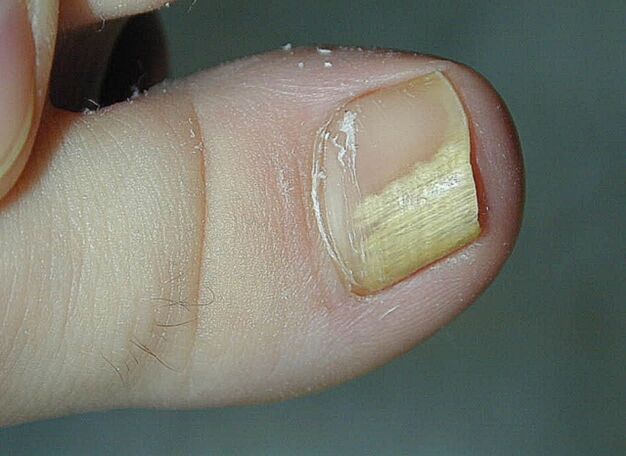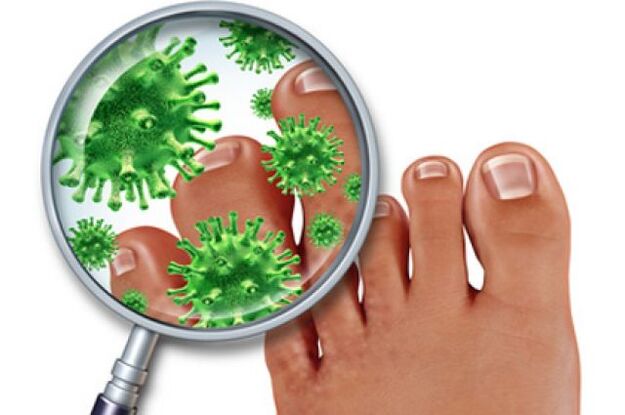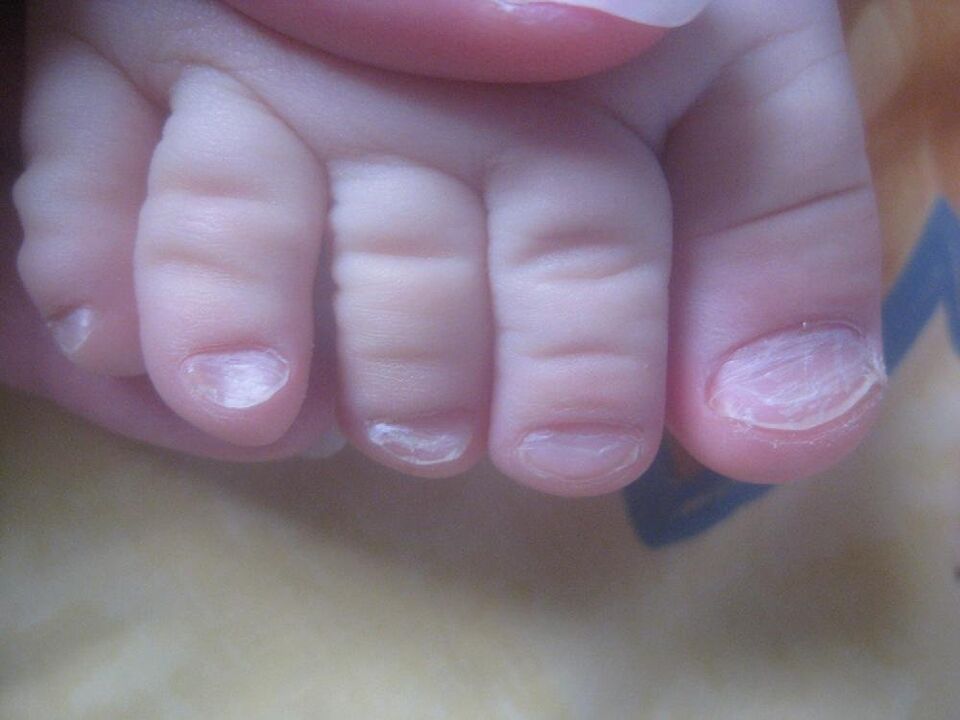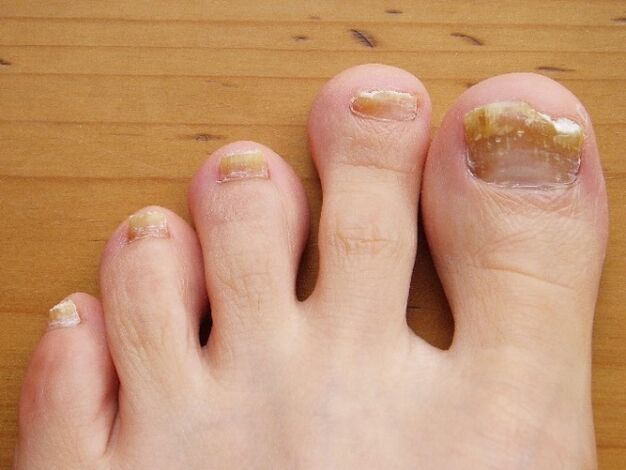Nail fungus or mycotic diseases of the nails and tissues of the hands and feet are common infectious diseases. It is caused by a yeast fungus that destroys nail plates and causes skin inflammation. In medicine, this disease is called onychomycosis or paronychia. The standard misconception is the claim that only people who do not keep their hands and feet clean can get fungal diseases. Often, nail fungus affects those who have had to stay in shoes for long periods of time because of their profession or other circumstances.
symptoms
The classification of the disease depends on the type of infection and the localization of its spread.
- Normotropic onychomycosis is indicated by small changes in the structure of the nail plate in the form of spots and yellowish streaks along the nail. It is the least noticeable and usually does not cause any discomfort. The main concern is the appearance of nails, which in the early stages people try to hide it with the help of cosmetics.
- Hypertrophic onychomycosis causes an increase in the number of horny nail plates. With this disease, a person may experience pain when pressing a finger. This causes discomfort when walking with shoes on.
- Shallow white fungus is distinguished by roughness on the surface of the nail plate and unpleasant whitish spots.

Mycologists who specialize in fungal diseases can determine the cause of the disease and prescribe the right treatment.
Types of fungi
The symptoms of an infection with a fungal infection are similar, but doctors choose treatment depending on the type of fungus that is causing the disease.
- Dermatophyte is the most common fungus that causes violations of the nail plate and the surrounding tissue. Usually choose the thumb, little finger and the skin between the fingers. Easily cured with early diagnosis
- Candida begins its action on the skin between the fingers and moves to the nails.
- Fusarium and Alternaria molds are rare and are mostly found in people with immune disorders
Because of the appearance
The main cause of infection is a violation of hygiene standards. But someone who carefully monitors the hygiene of hands, feet and objects can become infected in public areas.
- Contact with fungal carriers and their belongings. This may be a visit to a bath or sauna, the use of individual foreign accessories or poorly processed manicure items.
- Excessive sweating on the feet creates a good environment for the spread of the fungus.
- The use of tight and poorly ventilated shoes made of artificial materials contributes to the creation of high humidity, helps the development of the disease.
- A weakened immune system cannot fight infection.
- Treatment with antibiotics leads to a weakening of the immune system and the decomposition of the body's own microflora.
- Long-term taking antibacterial agents that destroy beneficial bacteria along with those that cause disease
- Foot tract diseases reduce resistance and allow the fungus to disrupt the integrity of the skin for disease progression.
- The manifestation of diabetes mellitus in the form of skin disorders is a favorable environment for the development of fungal colonies.
- Wounds on the skin and cracks on the nails help the fungus to settle and begin its work.
- Visiting a nail salon can trigger the emergence of fungal infections if hygiene standards for processing tools are not adhered to.

In children
In childhood, fungal infections are less common. This is due to the characteristics of the organism. As you know, children's feet do not suffer from excessive sweating. However, going to the pool and gym can cause infections in children. Weakened immunity by the flu also contributes to this. At older ages and adolescents, when rapid hormonal changes occur in a child’s body, there is also a risk of getting a fungal infection. To protect against infection, it is necessary to monitor the cleanliness of shoes and wash them in a timely manner with antiseptic compounds.

One of the causes of fungal infections in children may be a lack of vitamins in the body. It is desirable to fill the deficiency with the help of proper nutrition and complex vitamin therapy. A doctor's consultation will help you choose a quality vitamin supplement composition for your child.
Development process
Favorable conditions are required for the development of fungal infections. Wet shoes from sweat and a neutral or slightly acidic environment create comfort for fungal reproduction.
Unpleasant nail appearance, itching and pain around the nail indicate a new infection. If you are not involved in the treatment, then after a while the fungus will completely destroy the nail plate and reach the soft tissues of the fingers and toes. At a later stage of disease development, there may be qualitative changes in the form of blisters filled with cloudy liquid with a strong unpleasant odor.
Complications
Diseases that commonly occur on the outer surface of the nail plate may not cause difficulties. In some cases, this condition can last for years. Carriers of the fungus do not suffer on their own, but are capable of transmitting the infection to others.
The consequences of fungal infections mainly affect the nails and the tissues around them, but in the future they can cause negative consequences for the health of the whole body.
The growth of fungal colonies causes pain in the feet and causes difficulty wearing shoes. Nails change shape and can grow into finger tissues, causing unbearable pain when walking.

The deterioration of the immune system, caused by toxins released by the fungus during its life, leads to frequent occurrence of colds and inflammatory processes in the body.
Allergic reactions caused by fungal work products lead to several side effects of the respiratory system and diseases of the liver and kidneys.
Infections that have settled in the body can cause conjunctivitis, rhinitis of various etiologies. Itching on the skin, red spots and irritation can affect not only the place of initial localization of fungal colonies, but also go to the skin of the body and head. This also affects the condition of the hair and facial skin. Probably part of the cause of dandruff.
The constant itching and discomfort caused by the disease is a fairly common reason to visit a neurologist and psychotherapist.
Further forms of the disease can lead to nail loss and deformity of bones and joints.
prevention
To prevent infection, it is necessary to adhere to hygiene standards carefully not only when visiting public places, but also private places.

It is prohibited:
- Use regular hygiene items. Every family member should have nail clippers, foot towels, soap and more.
- You can't use other people's shoes. Through slippers shared in the family, the infection is easily spread.
- Wash sick people's belongings with others. Keep in mind that not all detergents and cleaning compounds are capable of destroying fungus. The infection is very persistent. The clothing items of the sick person should be treated with a special solution. This is especially true for shoes. It must be rinsed thoroughly inside and often change the inside.

























